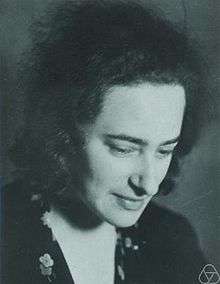Olga Taussky-Todd
| Olga Taussky-Todd | |
|---|---|
 1932 in Göttingen | |
| Born |
August 30, 1906 Olomouc, Austria-Hungary (present-day Olomouc, Czech Republic) |
| Died |
October 7, 1995 (aged 89) Pasadena, California, U.S. |
| Alma mater | Doctorate, University of Vienna supervised by Philipp Furtwängler |
| Employer | National Physical Laboratory, University of London, National Bureau of Standards, California Institute of Technology |
| Organization | Vienna Circle |
| Known for | Torchbearer for matrix theory; supervised Caltech's first female Ph.D. in Math, Lorraine Foster; corrected David Hilbert's papers |
| Spouse(s) | John Todd |
| Parent(s) | Julius David Taussky, Ida Pollach |
| Awards | Fellow of Girton College, Bryn Mawr College, and the AAAS, a Noether Lecturer and a recipient of the Austrian Cross of Honour for Science and Art, 1st class |
Olga Taussky-Todd (August 30, 1906, Olomouc, Austria-Hungary (present-day Olomouc, Czech Republic) – October 7, 1995, Pasadena, California) was an Austrian and later Czech-American mathematician.[1][2] She is famous for her more than 300 research papers in algebraic number theory, integral matrices, and matrices in algebra and analysis.
Early life
Olga Taussky was born into a Jewish family in what is now Olomouc, Czech Republic, on August 30, 1906. Her father, Julius David Taussky, was an industrial chemist and her mother, Ida Pollach, was a housewife. She was the second of three children.[2]
At the age of three, her family moved to Vienna and lived there until the middle of World War I. Later Taussky's father accepted a position as director of a vinegar factory at Linz in Upper Austria. At a young age, Taussky displayed a keen interest in mathematics. After her father died during her last year at school, she worked through the summer at her father's vinegar factory and was pressured by her family to study chemistry in order to take over her father's work. Once her older sister qualified in chemistry and took over her father's work, however, Taussky became free to study mathematics when she enrolled at the University of Vienna in the fall of 1925.[2]
Career
Taussky worked first in algebraic number theory, with a doctorate at the University of Vienna supervised by Philipp Furtwängler, a famous number theoretician from Germany.[3] During that time in Vienna she also attended the meetings of the Vienna Circle.
Taussky is most well known for her work in matrix theory (in particular the computational stability of complex matrices) algebraic number theory, group theory, and numerical analysis.
According to Gian-Carlo Rota, as a young mathematician she was hired by a group of German mathematicians to find and correct the many mathematical errors in the works of David Hilbert, so that they could be collected into a volume to be presented to him on his birthday. There was only one paper, on the continuum hypothesis, that she was unable to repair.[4]
Later, she started to use matrices to analyze vibrations of airplanes during World War II, at the National Physical Laboratory in the United Kingdom. During this time she wrote several articles that were published by the Ministry of Aircraft Production in London. She later described herself as a torchbearer for matrix theory.
In 1935, she moved to England and became a Fellow at Girton College, Cambridge University, as well as at Bryn Mawr College. Soon after, in 1938, she married the British mathematician John Todd (1911-2007), a colleague at the University of London.
In 1945 the Todds emigrated to the United States and worked for the National Bureau of Standards. In 1957 she and her husband both joined the faculty of California Institute of Technology (Caltech) in Pasadena, California. She also supervised Caltech's first female Ph.D. in Math, Lorraine Foster.
Taussky retired from teaching in 1977, but continued her correspondence with other mathematicians regarding her work in matrix theory.
Awards and honors
Taussky received the Ford Prize for an article on sum of squares published in 1970 in American Mathematical Monthly. She went on to receive an honorary doctorate from the University of Vienna and an honorary DSc by the University of Southern California in 1988.
She was a Fellow of the AAAS, a Noether Lecturer and a recipient of the Austrian Cross of Honour for Science and Art, 1st class (1978).
In 1993, the International Linear Algebra Society established a lecture series to honor the contributions to the field of linear algebra made by Taussky-Todd and her husband.
See also
Selected Publications
- How I became a torchbearer for matrix theory, American Mathematical Monthly. v. 95, 1988
- Olga Taussky, "A recurring theorem on determinants," Amer. Math. Monthly. 56 (1949) 673-676.
- Olga Taussky, "Generalized commutators of matrices and permutations of factors in a product of three matrices," Studies in Mathematics and Mechanics presented to Richard von Mises, Academic Press, NY, 1954.
- Olga Taussky and John Todd, "Infinite powers of matrices," J. London Math. Soc. 17 (1942) 147-151.
- Olga Taussky, "Matrices C with Cn → 0," J. Algebra, 1 (1954) 5-10.
- Olga Taussky and John Todd, "Matrices with finite period," Proc. Edinburgh Math. Soc. 6 (1939) 128-134.
- Olga Taussky, "On a theorem of Latimer and MacDuffee," Canad. J. Math. 1 (1949) 300-302.
- Sums of squares, American Mathematical Monthly. v. 77, 1970
References
- ↑ "Olga Taussky-Todd", Biographies of Women Mathematicians, Agnes Scott College
- 1 2 3 O'Connor, John J.; Robertson, Edmund F., "Olga Taussky-Todd", MacTutor History of Mathematics archive, University of St Andrews.
- ↑ Olga Taussky-Todd at the Mathematics Genealogy Project
- ↑ Rota, Gian-Carlo (2008), Indiscrete Thoughts, Modern Birkhäuser Classics, Springer, p. 201, ISBN 9780817647803.
External links
- Narrative overview
- Noether Booklet
- Noether Booklet
- Luchins, Edith H.; McLoughlin, Mary Ann (August 1996). "In Memoriam: Olga Taussky-Todd" (PDF). Notices of the American Mathematical Society. 43 (8): 838–847.